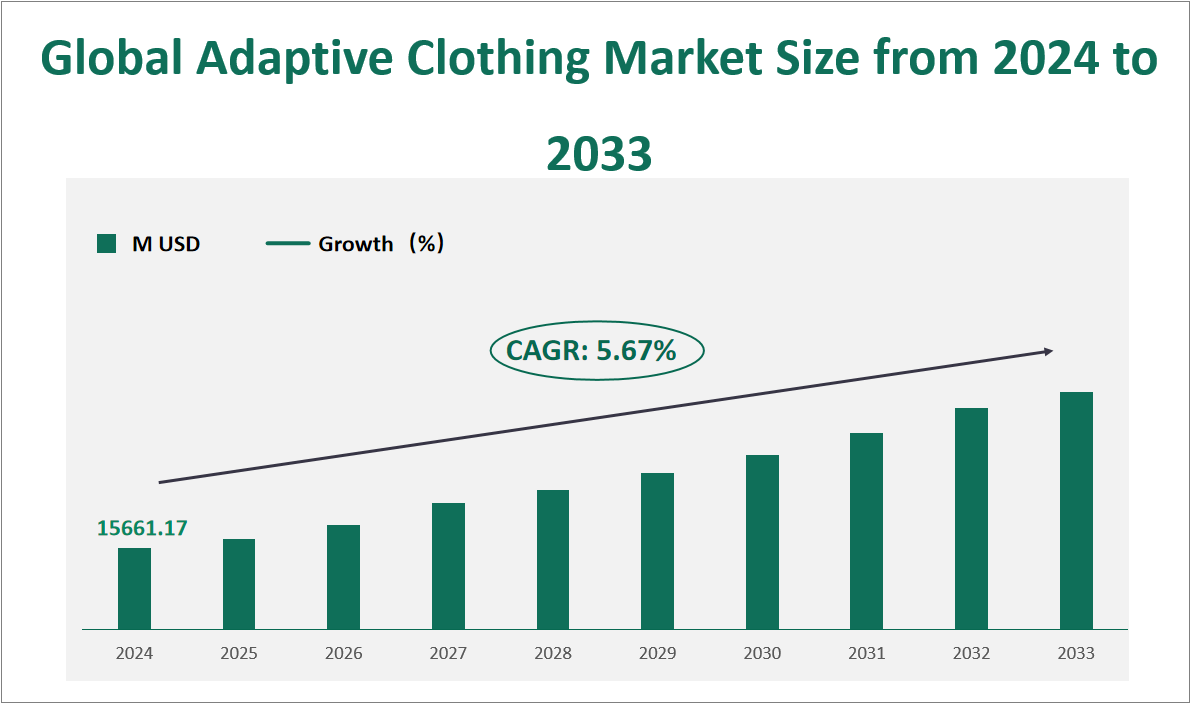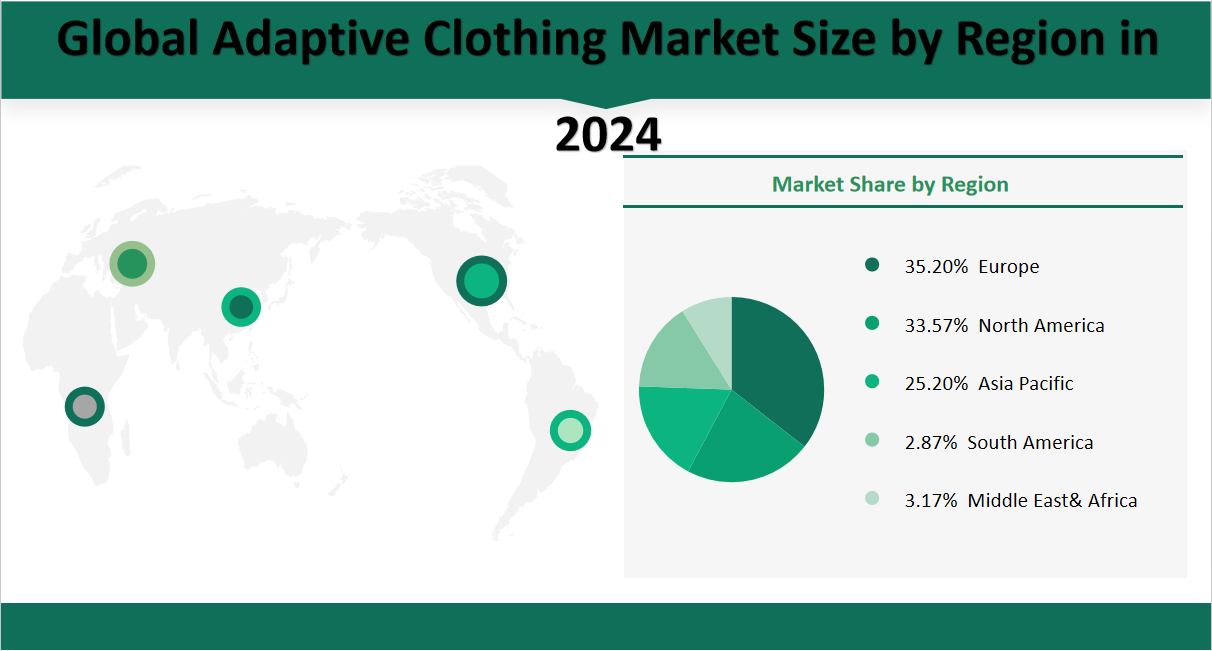1 Global Adaptive Clothing Market Outlook
The global Adaptive Clothing market is projected to exhibit substantial growth in the coming years, with a CAGR of 5.67% from 2024 to 2033, reaching a total market size of $15661.17 million USD in 2024. Adaptive clothing is not merely a niche market but a necessity for millions of people worldwide. According to the World Health Organization, approximately 785 million individuals aged 15 and above have some form of disability. This demographic, along with the growing elderly population, represents a significant portion of the global market. Adaptive clothing is designed to address specific challenges faced by these groups, such as difficulty in manipulating buttons or zippers, limited range of motion, and the need for easy access to medical devices. The market includes a wide range of products, from adaptive dresses and tops to specialized footwear and accessories, all aimed at enhancing independence and dignity for users.
Figure Global Adaptive Clothing Market Size and Growth Rate (2024-2033)

2 Adaptive Clothing Market Growth Drivers and Constraints
The growth of the Adaptive Clothing market is influenced by several key drivers and constraints. On the positive side, the increasing prevalence of disabilities and chronic conditions such as arthritis and diabetes is a major driver. For instance, the Centers for Disease Control and Prevention (CDC) reported that over 54 million adults in the U.S. alone suffered from arthritis between 2013 and 2015. Adaptive clothing, with its easy-to-use designs, provides a practical solution for such individuals. Additionally, the growing elderly population in regions like Europe and Asia-Pacific is fueling demand, as older adults often require clothing that is easier to put on and take off.
Another significant driver is the increasing awareness and acceptance of adaptive clothing among both consumers and healthcare providers. The market is also benefiting from technological advancements, such as the development of smart textiles and wearable technology that can monitor health conditions. For example, adaptive clothing with integrated sensors can track vital signs, providing valuable data to caregivers and medical professionals.
However, the market faces several limiting factors. One major challenge is the lack of awareness about the availability and benefits of adaptive clothing. Many consumers, especially in developing countries, are unaware of the options available to them. Additionally, the relatively high cost of adaptive clothing, driven by specialized manufacturing processes and materials, can be a barrier to entry for some consumers. The market also faces intense competition, with both global and local players vying for market share. This competition can lead to price wars and the proliferation of sub-standard products, which can harm the reputation of the industry.
3 Adaptive Clothing Market Innovations and M&A Activities
The Adaptive Clothing market is witnessing significant technological innovation and corporate activity. Companies are increasingly investing in research and development to create more functional and aesthetically pleasing adaptive clothing. For example, brands like Tommy Hilfiger have launched adaptive collections that not only meet functional needs but also adhere to fashion trends. These collections often feature innovative designs such as one-handed zippers, adjustable waistbands, and magnetic closures that make dressing easier for individuals with disabilities.
Corporate mergers and acquisitions are also shaping the market landscape. Major players are acquiring smaller, niche companies to expand their product portfolios and gain a competitive edge. For instance, some large fashion brands have acquired adaptive clothing startups to integrate their technologies and designs into mainstream collections. This trend is expected to continue as companies seek to diversify their offerings and tap into the growing demand for adaptive clothing.
In addition to mergers and acquisitions, companies are also forming strategic partnerships to enhance their market presence. These partnerships often involve collaborations with healthcare providers, occupational therapists, and engineers to develop products that meet the specific needs of users. For example, some adaptive clothing manufacturers are working with hospitals to design clothing that facilitates easier access to medical devices while maintaining patient dignity.
In conclusion, the global Adaptive Clothing market is poised for significant growth, driven by increasing demand from the elderly and disabled populations, technological advancements, and growing awareness. However, the market also faces challenges such as high costs and intense competition. Companies that can innovate and adapt to these trends while addressing consumer needs will be well-positioned to capture a larger share of this expanding market.
4 Global Adaptive Clothing Market Analysis by Type
In 2024, the global Adaptive Clothing market is forecasted to reach a total value of $15,661.17 million USD. Among the different types of adaptive clothing, Adaptive Dresses are expected to account for a market value of $4,433.87 million USD, representing a market share of 28.31%. Adaptive Tops & Pants are projected to have a market value of $7,827.75 million USD, holding a market share of 49.98%. The “Others” category, which includes various other adaptive clothing items, is anticipated to reach a market value of $3,399.56 million USD, with a market share of 21.71%.
Table Global Adaptive Clothing Market Size and Share by Type in 2024
Type | Market Size in 2024 (M USD) | Market Share in 2024 (%) |
|---|---|---|
Adaptive Dresses | 4433.87 | 28.31% |
Adaptive Tops & Pants | 7827.75 | 49.98% |
Others | 3399.56 | 21.71% |
5 Global Adaptive Clothing Market Analysis by Application
In 2024, the global Adaptive Clothing market is projected to reach a total value of $15,661.17 million USD. Among the key application areas, Adaptive Clothing for Disabled Adults is expected to hold the largest market value at $7,300.89 million USD, accounting for 46.62% of the total market share. For Wheelchair Users, the market value is forecasted to be $3,851.94 million USD, representing 24.60% of the market. The segment for the Elderly is anticipated to reach $3,895.59 million USD, with a market share of 24.87%. Lastly, the Others category, which includes other specialized applications, is expected to have a market value of $612.75 million USD, making up 3.91% of the total market share.
Table Global Adaptive Clothing Market Size and Share by Application in 2024
Application | Market Size in 2024 (M USD) | Market Share in 2024 (%) |
|---|---|---|
Disabled Adults | 7300.89 | 46.62% |
Wheelchair Users | 3851.94 | 24.60% |
Elderly | 3895.59 | 24.87% |
Others | 612.75 | 3.91% |
6 Global Adaptive Clothing Market Analysis by Region
In 2024, the global Adaptive Clothing market is forecasted to reach a total value of $15,661.17 million USD. Among the major regions, North America is expected to hold the largest market value at $5,256.85 million USD, accounting for 33.57% of the global market share. Europe follows closely with a market value of $5,511.99 million USD, representing 35.20% of the total market. Asia Pacific is projected to have a market value of $3,946.50 million USD, contributing 25.20% to the global market. South America is expected to reach $449.22 million USD, holding a share of 2.87% of the global market. Meanwhile, Middle East and Africa will have a market value of $496.61 million USD, accounting for 3.17% of the total market.
Figure Global Adaptive Clothing Market Share by Region in 2024

7 Top 3 Companies of Global Adaptive Clothing Market
7.1 Target Corporation
Company Introduction and Business Overview:
Target Corporation, founded in 1902 and headquartered in the United States, is a leading retail corporation known for its wide range of general merchandise and commitment to offering affordable, high-quality products. The company operates a network of discount stores across the U.S., catering to a diverse customer base. Target’s business model emphasizes customer satisfaction, innovation, and community engagement. In recent years, Target has expanded its focus to include adaptive clothing, recognizing the growing need for inclusive fashion solutions.
Products Offered:
Target’s adaptive clothing line includes a variety of products designed to meet the unique needs of individuals with disabilities and limited mobility. Their offerings include adaptive dresses, tops, pants, and accessories, all featuring easy-to-use closures such as Velcro, magnetic fasteners, and elastic waistbands. These designs ensure that dressing and undressing are simpler and more comfortable for users. Target’s adaptive clothing is available in a range of styles and sizes, catering to both adults and children. Notably, Target has introduced adaptive clothing for children under its Cat & Jack™ brand, featuring designs like the Girls’ Adaptive 4th of July Short Sleeve Graphic T-Shirt. This product incorporates flat seams and no tags for enhanced comfort, making it a popular choice for young users.
Sales Revenue in the Latest Year:
Target’s adaptive clothing segment reported a revenue of $209.56 million USD. This growth reflects Target’s successful integration of adaptive clothing into its product portfolio and its commitment to meeting the needs of a broader customer base. Despite the challenges posed by the COVID-19 pandemic, Target managed to maintain a strong market presence through its robust online and offline retail channels. The company’s adaptive clothing line has been well-received by consumers, contributing to its overall market performance.
7.2 Kohl’s Corporation
Company Introduction and Business Overview:
Kohl’s Corporation, established in 1962 and headquartered in the United States, is a prominent retail company specializing in family-oriented department stores. Kohl’s offers a wide range of apparel, footwear, and accessories for men, women, and children. The company is known for its commitment to providing high-quality products at affordable prices. In recent years, Kohl’s has expanded its product offerings to include adaptive clothing, recognizing the growing market demand for inclusive fashion solutions.
Products Offered:
Kohl’s adaptive clothing line includes a variety of products designed to cater to individuals with disabilities and limited mobility. Their offerings include adaptive tops, pants, and accessories, featuring easy-to-use closures such as Velcro and magnetic fasteners. Kohl’s has also introduced adaptive clothing for children, including products like the Boys’ Adaptive School Trousers. These trousers feature a pull-on waistband, flat seams, and no tags, making them comfortable and easy to wear. Kohl’s adaptive clothing is available in a range of styles and sizes, ensuring that it meets the needs of a diverse customer base.
Sales Revenue in the Latest Year:
Kohl’s adaptive clothing segment reported a revenue of $168.59 million USD. This growth reflects Kohl’s successful expansion into the adaptive clothing market and its commitment to offering inclusive fashion solutions. Despite the challenges posed by the COVID-19 pandemic, Kohl’s managed to maintain a strong market presence through its robust retail network and online platform. The company’s adaptive clothing line has been well-received by consumers, contributing to its overall market performance.
7.3 Marks & Spencer
Company Introduction and Business Overview:
Marks & Spencer, founded in 1884 and headquartered in the United Kingdom, is a leading multinational retailer specializing in clothing, home products, and food. The company is known for its commitment to quality, innovation, and customer satisfaction. In recent years, Marks & Spencer has expanded its product offerings to include adaptive clothing, recognizing the growing market demand for inclusive fashion solutions.
Products Offered:
Marks & Spencer’s adaptive clothing line includes a variety of products designed to cater to individuals with disabilities and limited mobility. Their offerings include adaptive dresses, tops, pants, and accessories, featuring easy-to-use closures such as Velcro and magnetic fasteners. Marks & Spencer has also introduced adaptive clothing for children, including products like the Boys’ Adaptive School Trousers. These trousers feature a pull-on waistband, flat seams, and no tags, making them comfortable and easy to wear. Marks & Spencer’s adaptive clothing is available in a range of styles and sizes, ensuring that it meets the needs of a diverse customer base.
Sales Revenue in the Latest Year:
Marks & Spencer’s adaptive clothing segment reported a revenue of $59.25 million USD. This growth reflects Marks & Spencer’s successful expansion into the adaptive clothing market and its commitment to offering inclusive fashion solutions. Despite the challenges posed by the COVID-19 pandemic, Marks & Spencer managed to maintain a strong market presence through its robust retail network and online platform. The company’s adaptive clothing line has been well-received by consumers, contributing to its overall market performance.

